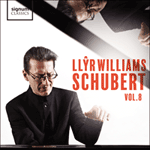When Liszt issued his
Sechs Melodien von Franz Schubert in 1844, he was as unaware as most of the musical world at the time that the first song which he transcribed was a misattribution to Schubert. The piece is nevertheless offered here to keep Liszt’s collection intact, and the obscurity into which it would fall if listed as a song by its true author is reason enough to preserve its quite Schubertian beauty in the noble context which Liszt intended.
Lebe wohl! (‘Fare well!’) was composed by Hans von Weyrauch, who was born, as the excellent Neue Liszt-Ausgabe informs us, in 1788, and who wrote the song as
Nach Osten! (‘To the East!’) in 1824, but it was reissued in 1843 with new words (by Branger) as
Adieu and translated as ‘Lebe wohl!’ under Schubert’s name. (It is still published by Schirmer in one of their collections of Schubert Songs!) The simple text bids farewell to a dead loved one, and Liszt’s transcription retains simplicity, even though the texture of the accompaniment is greatly varied over the two verses of the song. The Schiller song
Des Mädchens Klage (‘The Maiden’s Lament’, D191b) brings us to Schubert proper, and a complex transcription cast as a theme and variations dramatically depicting the maiden’s discovery, having lived and loved a little, that sorrow and tears follow hard on the heels of joy.
Das Zügenglöcklein, D871b—the title which Liszt knew,
Das Sterbeglöcklein, amounts to the same thing—is a strophic prayer for the unknown dead being tolled by a distant bell. Again Liszt sets the work as a theme and variations of great refinement and intricacy.
Trockne Blumen (‘Dried Flowers’, D795/18) comes from
Die schöne Müllerin. The poet speaks to a few dead flowers which were the only gift he had had from his beloved. If the flowers were buried in his grave, and if she realized that his feelings had been true, then the flowers would spring to life again. Liszt’s arrangement (in C minor, rather than Schubert’s E minor) is quite straightforward, and the hope of the second part of the song is accentuated by his placing the material octaves higher than the original.
Ungeduld, D795/7 is also from
Schwanengesang and is Liszt’s first transcription of the piece (in F major rather than Schubert’s A major) and, like the second transcription, is a theme and variations one verse shorter than the original. Curiously, it approches the business of conveying the poet’s impatient passion in quite a different way from the later transcription, and adds a short, extremely blue. coda. Finally,
Die Forelle, D550d, is given a full-blooded concert transcription.
from notes by Leslie Howard © 1995
Lorsque Liszt publia ses
Sechs Melodien von Franz Schubert en 1844, il n’était pas conscient, tout comme la plupart du monde musical à l’époque, que le premier chant qu’il avait transcrit était faussement attribué à Schubert. Le morceau est néanmoins présenté ici afin de garder intacte la collection de Liszt, et l’obscurité dans laquelle il tomberait s’il était classé comme un chant de son véritable compositeur constitue une raison suffisante pour préserver sa beauté assez schubertienne dans le noble contexte souhaité par Liszt.
Lebe wohl! («Adieu!») fut composé par Hans von Weyrauch, qui est né, comme nous en informe l’excellent Neue Liszt-Ausgabe, en 1788, et qui écrivit le chant sous le titre
Nach Osten! («Vers l’est!») en 1824, mais celui-ci fut publié à nouveau en 1843 avec de nouvelles paroles (de Béranger) sous le titre d’
Adieu, et traduit par
Lebe wohl! sous le nom de Schubert. (Ce chant est encore publié par Schirmer dans l’une de ses collections de chants de Schubert!) Le simple texte présente des adieux à une bien-aimée décédée, et la transcription de Liszt conserve une certaine simplicité, même si la texture de l’accompagnement est très variée sur l’ensemble des deux couplets du chant.
Le chant de Schiller Des Mädchens Klage, D191b («La complainte de la jeune fille») nous conduit au vrai Schubert, et une transcription complexe apparaît comme un thème avec variations dépeignant de manière spectaculaire la découverte de la jeune fille, qui a peu vécu et aimé, du fait que la peine et les larmes suivent la joie de très près. Das Zügenglöcklein, D871b («Le glas pour les défunts»)—que Liszt connaissait sous le titre: Das Sterbeglöcklein, qui revient au même—est une prière à strophes à l’attention du défunt inconnu, pour qui sonne le glas dans le lointain. A nouveau, Liszt met en musique l’œuvre sous la forme de thème avec variations, d’un raffinement et d’une complexité importants. Trockne Blumen, D795/18 («Fleurs séchées») provient de Die schöne Müllerin. Le poète s’adresse à quelques fleurs fanées, qui étaient le seul cadeau qu’il ait reçu de sa bien-aimée. Si les fleurs étaient enterrées dans sa tombe, et si elle réalisait que ses sentiments avaient été sincères, alors les fleurs reviendraient à la vie. L’arrangement de Liszt—en do mineur, plutôt que le mi mineur de Schubert—est assez direct, et l’espoir qui figure dans la seconde partie du chant est accentué par le fait que Liszt place les octaves importantes plus haut que dans l’original.
Ungeduld, D795/7 («Impatience»), est aussi tiré de Schwanengesang, et représente la première transcription du morceau par Liszt, en Fa majeur plutôt qu’en la majeur comme Schubert, et, tout comme la seconde transcription, est un thème avec variations plus court d’un couplet que l’original; curieusement, celui-ci approche le problème de transmettre la passion impatiente du poète d’une manière qui diffère de la transcription plus récente, et ajoute une coda courte, extrêmement triste. Finalement, Die Forelle, D550d («La truite») est dotée d’une transcription vigoureuse pour concert.
extrait des notes rédigées par Leslie Howard © 1995
Français: Catherine Loridan
Als Liszt 1844 seine
Sechs Melodien von Franz Schubert herausgab, war er sich, wie viele seiner Zeitgenossen, nicht darüber klar, daß das erste Lied, das er transkribierte, Schubert fälschlich zugeschrieben worden war. Um Liszts Sammlung unversehrt wiederzugeben, wird dieses Stück hier trotzdem vorgetragen. Es würde sicherlich in Vergessenheit geraten, wenn es in Verzeichnissen unter dem Namen seines wahren Autoren aufgeführt würde, und dies ist Grund genug, seine wahrhaft Schubertsche Schönheit in dem vornehmen von Liszt intendierten Kontext zu bewahren.
Lebe wohl! ist eine Komposition von Hans von Weyrauch, der, wie uns die ausgezeichnete
Neue Liszt-Ausgabe mitteilt, 1788 geboren wurde und der das Lied 1824 mit dem Titel
Nach Osten! schrieb. Es wurde jedoch 1843 neu (und mit neuen Worten von Béranger) als
Adieu herausgegeben, und als
Lebe wohl! unter Schuberts Namen übersetzt. (Der Schirmer-Verlag druckt es noch immer in einer seiner Sammlungen von Schubert-Liedern!) Der simple Text hat ein Lebewohl an die tote Geliebte zum Inhalt, und Schuberts Transkription behält seine Schlichtheit bei, wenn die Struktur der Begleitung auch während der beiden Strophen des Liedes stark verändert wird; das Schillerlied
Des Mädchens Klage (D191b) bringt uns dann einen echten Schubert mitsamt einer Transkription in der Form eines Themas mit Variationen. Auf dramatische Weise wird geschildert, wie das Mädchen, das eine Weile gelebt und geliebt hat, entdeckt, daß Leid und Tränen dem Glück auf den Fersen folgen;
Das Zügenglöcklein (D871b)—der Liszt bekannte Titel
Das Sterbeglöcklein hat dieselbe Bedeutung—ist ein strophisches Gebet für die unbekannten Toten, die von einer entfernten Glocke zu Grabe geläutet werden. Wieder einmal setzt Liszt das Werk als sehr kunstvolles und kompliziertes Thema mit Variationen;
Trockne Blumen (D795/18) stammt aus der
Schönen Müllerin. Der Dichter spricht zu ein paar toten Blumen, die das einzige Geschenk waren, das er von seiner Liebsten erhielt. Würden die Blumen in seinem Grabe beerdigt, und würde die Geliebte erkennen, daß seine Gefühle echt waren, so würde dies die Blumen wieder zum Leben erwecken. Liszts Bearbeitung—in c-Moll, und nicht, wie bei Schubert, in e-Moll—ist ziemlich direkt, und die im zweiten Teil des Liedes ausgesprochene Hoffnung wird dadurch hervorgehoben, daß er den Stoff des Originals ein paar Oktaven höher setzt.
Ungeduld (D795/7) stammt ebenfalls aus dem
Schwanengesang, und ist Liszts erste Transkription dieses Stückes. Sie steht in F-Dur und nicht, wie bei Schubert, in A-Dur, und trägt wie die zweite Transkription die Form eines Themas mit Variationen, das eine Strophe kürzer als die Vorlage ist. Seltsamerweise stellt es die die ungeduldige Leidenschaft des Dichters mit ganz anderen Mitteln dar als die spätere Transkription, und fügt eine kurze, äußerst trübselige Koda hinzu; und zum Schluß wird der
Forelle (D550d) eine vollblütige Konzerttranskription zuteil.
aus dem Begleittext von Leslie Howard © 1995
Deutsch: Angelika Malbert


 Liszt: Complete Piano Music
Liszt: Complete Piano Music Schubert: A Schubert Journey
Schubert: A Schubert Journey Schubert: Piano Music, Vol. 8
Schubert: Piano Music, Vol. 8
